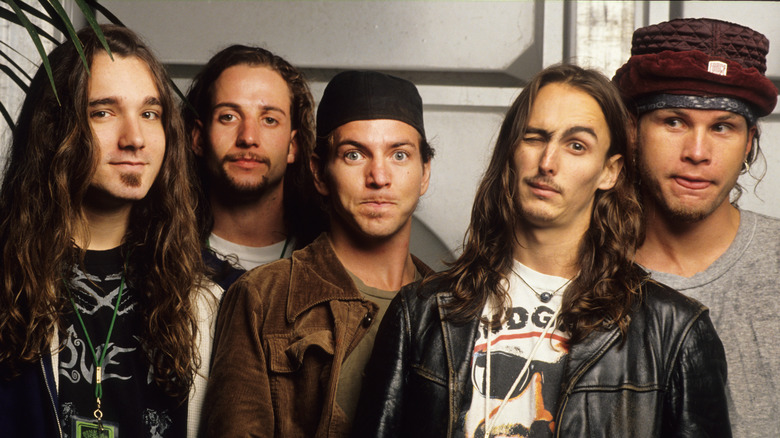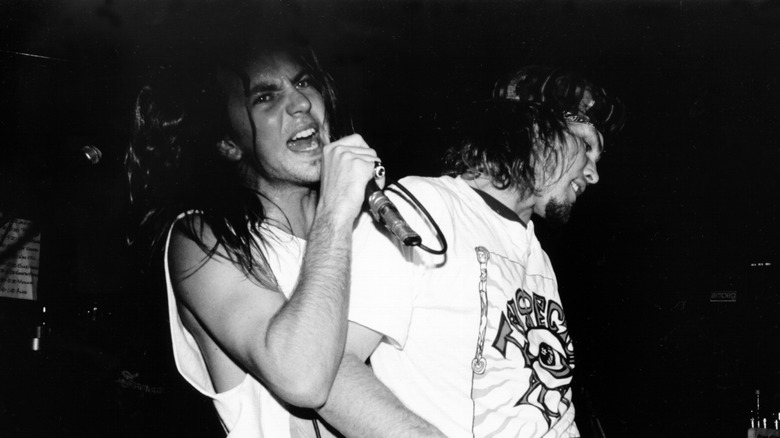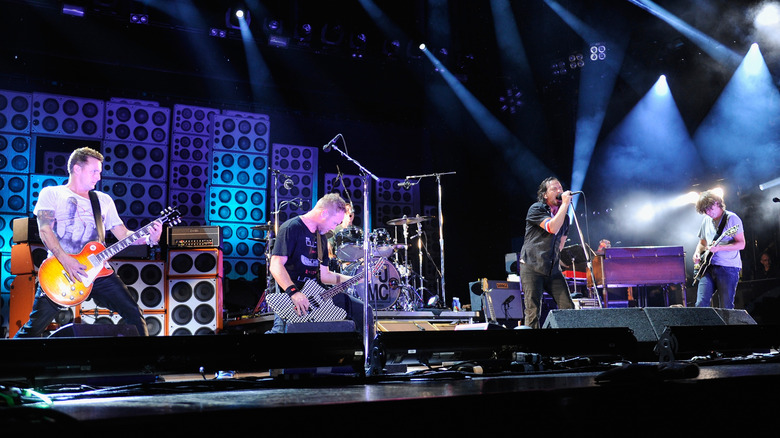Why Pearl Jam Once Refused To Make Music Videos
Pearl Jam burst into stardom in the early 1990s as part of the Seattle grunge rock scene, but their anti-authoritarian attitude toward the music industry quickly proved to be pretty punk rock. Or maybe it can just be chalked up to good ol' rock 'n' roll rebellion. Whatever you want to call it, besides being catapulted into megastardom right out of the gate with their debut album "Ten," the group is also known for pushing back against the norms and expectations of the music industry.
As musicians and artists, the band has often been outspoken about their disdain for the commercialization of their music. Most notably, Pearl Jam cancelled their 1994 tour because they didn't want Ticketmaster charging their fans exorbitant fees. They also refused to make music videos to promote their second, third, or fourth albums after they lost control of the ones the label released for their debut, "Ten."
It's safe to say that Pearl Jam frontman Eddie Vedder, lead guitarist Mike McCready, rhythm guitarist Stone Gossard, and bassist Jeff Ament have stood firm in their convictions. Dave Abbruzzese, who was the third of the band's five drummers thus far, didn't have qualms with Ticketmaster or making music videos, and he ended up leaving the band in '94. But the rest of Pearl Jam held to their ideals for a few more years. By 1998, the band could no longer fight Ticketmaster, with Vedder telling Classic Rock in 2011, "[W]e got to be crushed by a huge corporate giant right up close." Videos, however, were a different animal — they had a lot more control over whether they participated in those. After "Ten," music videos from Pearl Jam were few and far between, and they were only ever done on the group's terms.
Pearl Jam clashed with their record label over the Jeremy video
With Pearl Jam's "Ten" being a huge commercial success, their label, Epic, was eager to capitalize on the singles with music videos. In 1992, MTV was still a cultural touchstone, and videos were a given for just about any hit song. For their first video, the band wanted to record a live version of "Alive," but MTV only allowed the tracks from the records to be used. So they compromised and used live footage of the band performing the recorded song, as told by "Five Against One: The Pearl Jam Story" by Kim Neely. "It's not the greatest video in the world, but it's live, and I can sleep at night because I feel like it's totally representative," Eddie Vedder said of the work.
While Pearl Jam also released videos for the songs "Evenflow" and "Oceans" from "Ten," the real issue came from the video for the song "Jeremy." There were actually two videos made for that song — the one you saw on heavy rotation on MTV that won best video of the year at the MTV Music Video Awards in 1993, and the version that Pearl Jam hired a friend, Chris Cuffaro, to direct. Though Epic humored the band to appease them, knowing they were making the video with Cuffaro, in reality, the label wasn't having it. There was too much money on the line to take a chance with an unknown director and an independently made video. They hired veteran music video director Mark Pellington to shoot a more commercially friendly version, which the band participated in filming, probably to appease the label. In the end, Epic sent Pellington's video to MTV, winning the battle of wills, but going forward, Pearl Jam dug in their heels.
The band avoided appearing in music videos for a decade
Not only did Pearl Jam feel like they lost their autonomy over how they wanted their music visually depicted, but they also got feedback that solidified their approach to making music videos. Regardless of "Jeremy" winning an award for being the best music video of 1993, in true Gen X form, a musician from another band at the time told Jeff Ament: "I liked your hit, but the video sucked. It ruined my vision of the song." According to a 1993 Rolling Stone article by Cameron Crowe, Ament took that to heart, telling Eddie Vedder, "Ten years from now, I don't want people to remember our songs as videos."
Pearl Jam refused to participate in making any videos for their sophomore album, "Vs.," released in 1993. A lackluster video for the song "Daughter" was produced, but the camera just panned over different still shots as the song played. In 1994, "Vitalogy" came out, sans music videos, and 1996's "No Code" also had no videos. In 1998, the group brought in drummer Matt Cameron and finally put out a music video to accompany the song "Do the Evolution" from their album "Yield." The band, however, was not in the video. Instead, it was fully animated and featured various depictions of the dark side of humanity.
It wasn't until 2002 that Pearl Jam appeared in a music video for one of their songs, and by then, they had made their position on the matter known. In subsequent years, they released a few videos to accompany their new albums, but the MTV era was over. In 2024, they put out a live music video of a performance of the song "Wreckage" filmed in Las Vegas, which was all they wanted to do in the first place.


